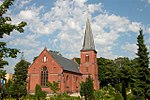Lillgrund Wind Farm
2008 establishments in SwedenBuildings and structures in the Øresund RegionEnergy infrastructure completed in 2008Offshore wind farms in the Baltic SeaSwedish building and structure stubs ... and 3 more
Vattenfall wind farmsWind farm stubsWind farms in Sweden

Lillgrund Wind Farm is located about 10 km off the coast of southern Sweden, just south of the Öresund Bridge, where average wind speeds are 8 to 10 metres per second (26 to 33 ft/s). With 48 wind turbines (Siemens SWT-2.3-93) and a capacity of 110 megawatts (MW), Lillgrund is Sweden's largest offshore wind farm. It was designed to meet the domestic electricity demand of more than 60,000 homes. The farm's turbines have a rotor diameter of 93 metres and a total height of 115 metres.A 2016 study found no significant effect on marine life.The music video for "Peroxide", a song by British-Swedish singer Ecco2K included on his studio album E (2019), was filmed at the Lillgrund Wind Farm.
Excerpt from the Wikipedia article Lillgrund Wind Farm (License: CC BY-SA 3.0, Authors, Images).Lillgrund Wind Farm
Malmö kommun
Geographical coordinates (GPS) Address Nearby Places Show on map
Geographical coordinates (GPS)
| Latitude | Longitude |
|---|---|
| N 55.52 ° | E 12.78 ° |
Address
Malmö kommun (Malmö stad)
Malmö kommun
Sweden
Open on Google Maps









